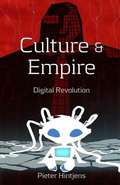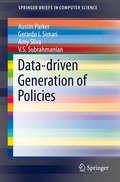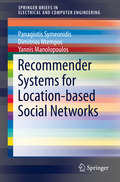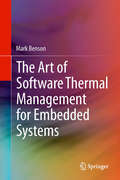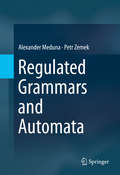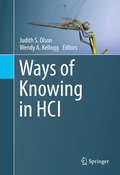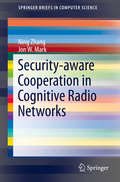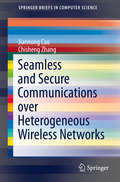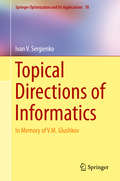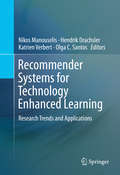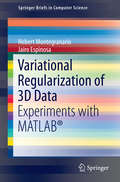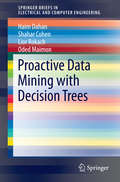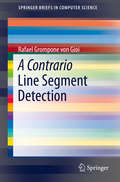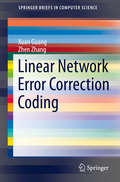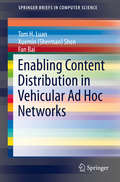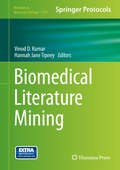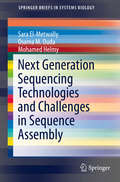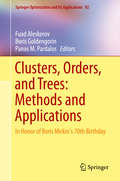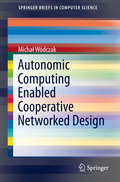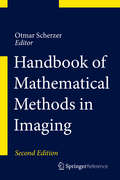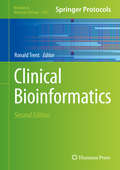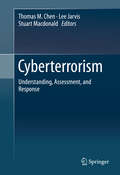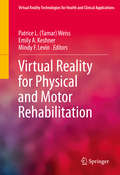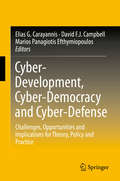- Table View
- List View
Turning Center Programming, Setup, and Operation Textbook: A Guide To Mastering The Use Of CNC Turning Centers
by Mike LynchIt is the intention of this text to introduce beginners and experienced CNC people alike to programming, setup, and operation techniques used to utilize CNC turning centers. We will begin in a basic manner, ensuring that even newcomers to CNC will be able to follow the presentations. And we use a building blocks approach -- so as you get deeper into the material -- we'll be adding to what you already know. When you're finished, you will have a thorough understanding of what it takes to program, setup, and run a CNC turning center. We use a Key Concepts approach to presenting CNC. The Key Concepts allow us to minimize the number of major topics you must master in order to become proficient with CNC turning center usage.
Culture & Empire: Digital Revolution
by Pieter HintjensThe whole planet is getting connected and building vast new communities. Our new communities are a very real challenge to old power and old money. And old money -- after its War on Drugs and War on Terror -- is now launching its War on the Internet. What is going on, and where will this lead us? Pieter Hintjens tells all in this vast story of Culture & Empire: Digital Revolution.
Data-driven Generation of Policies (SpringerBriefs in Computer Science)
by Amy Sliva V. S. Subrahmanian Austin Parker Gerardo I. SimariThis Springer Brief presents a basic algorithm that provides a correct solution to finding an optimal state change attempt, as well as an enhanced algorithm that is built on top of the well-known trie data structure. It explores correctness and algorithmic complexity results for both algorithms and experiments comparing their performance on both real-world and synthetic data. Topics addressed include optimal state change attempts, state change effectiveness, different kind of effect estimators, planning under uncertainty and experimental evaluation. These topics will help researchers analyze tabular data, even if the data contains states (of the world) and events (taken by an agent) whose effects are not well understood. Event DBs are omnipresent in the social sciences and may include diverse scenarios from political events and the state of a country to education-related actions and their effects on a school system. With a wide range of applications in computer science and the social sciences, the information in this Springer Brief is valuable for professionals and researchers dealing with tabular data, artificial intelligence and data mining. The applications are also useful for advanced-level students of computer science.
Recommender Systems for Location-based Social Networks
by Panagiotis Symeonidis Dimitrios Ntempos Yannis ManolopoulosOnline social networks collect information from users' social contacts and their daily interactions (co-tagging of photos, co-rating of products etc. ) to provide them with recommendations of new products or friends. Lately, technological progressions in mobile devices (i. e. smart phones) enabled the incorporation of geo-location data in the traditional web-based online social networks, bringing the new era of Social and Mobile Web. The goal of this book is to bring together important research in a new family of recommender systems aimed at serving Location-based Social Networks (LBSNs). The chapters introduce a wide variety of recent approaches, from the most basic to the state-of-the-art, for providing recommendations in LBSNs. The book is organized into three parts. Part 1 provides introductory material on recommender systems, online social networks and LBSNs. Part 2 presents a wide variety of recommendation algorithms, ranging from basic to cutting edge, as well as a comparison of the characteristics of these recommender systems. Part 3 provides a step-by-step case study on the technical aspects of deploying and evaluating a real-world LBSN, which provides location, activity and friend recommendations. The material covered in the book is intended for graduate students, teachers, researchers, and practitioners in the areas of web data mining, information retrieval, and machine learning.
The Art of Software Thermal Management for Embedded Systems
by Mark BensonThis book introduces Software Thermal Management (STM) as a means of reducing power consumption in a computing system in order to manage heat, improve component reliability and increase system safety. Readers will benefit from this pragmatic guide to the field of STM for embedded systems and its catalog of software power management techniques. Since thermal management is a key bottleneck in embedded systems design, this book focuses on root cause of heat in embedded systems: power. Since software has an enormous impact on power consumption in an embedded system, this book urges software engineers to manage heat effectively by understanding, categorizing and developing new ways to reduce static and dynamic power consumption. Whereas most books on thermal management describe mechanisms to remove heat, this book focuses on ways for software engineers to avoid generating heat in the first place.
Regulated Grammars and Automata
by Alexander Meduna Petr ZemekThis is the first book to offer key theoretical topics and terminology concerning regulated grammars and automata. They are the most important language-defining devices that work under controls represented by additional mathematical mechanisms. Key topics include formal language theory, grammatical regulation, grammar systems, erasing rules, parallelism, word monoids, regulated and unregulated automata and control languages. The book explores how the information utilized in computer science is most often represented by formal languages defined by appropriate formal devices. It provides both algorithms and a variety of real-world applications, allowing readers to understand both theoretical concepts and fundamentals. There is a special focus on applications to scientific fields including biology, linguistics and informatics. This book concludes with case studies and future trends for the field. Regulated Grammars and Automata is designed as a reference for researchers and professionals working in computer science and mathematics who deal with language processors. Advanced-level students in computer science and mathematics will also find this book a valuable resource as a secondary textbook or reference.
Ways of Knowing in HCI
by Judith S. Olson Wendy A. KelloggThis textbook brings together both new and traditional research methods in Human Computer Interaction (HCI). Research methods include interviews and observations, ethnography, grounded theory and analysis of digital traces of behavior. Readers will gain an understanding of the type of knowledge each method provides, its disciplinary roots and how each contributes to understanding users, user behavior and the context of use. The background context, clear explanations and sample exercises make this an ideal textbook for graduate students, as well as a valuable reference for researchers and practitioners. 'It is an impressive collection in terms of the level of detail and variety. ' (M. Sasikumar, ACM Computing Reviews #CR144066)
Security-aware Cooperation in Cognitive Radio Networks
by Ning Zhang Jon W. MarkThis brief investigates spectrum efficient and energy efficient strategies, known as cognitive radio networks (CRNs), to ensure secure cooperation between licensed and unlicensed users. The authors address issues of spectrum scarcity, spectrum sensing, transmission performance, trust-aware cooperation, and secure communications. Two security-aware cooperation based spectrum access schemes are presented. The first is a trust-aware cooperative framework for CRNs to improve the throughput or energy efficiency of licensed users and offer transmission opportunities to unlicensed users, taking into consideration the trustworthiness of unlicensed users. The second scheme is a cooperative framework to enhance secure communications of licensed users. An introduction to CRNs and literature survey enhance the discussion while numerical results are provided to demonstrate the viability of the proposed schemes. The brief is designed for researchers and professionals working with cognitive radio networks or interested in cooperation based access. Advanced-level students studying computer communication networks and communications engineering will also find this brief useful.
Seamless and Secure Communications over Heterogeneous Wireless Networks
by Jiannong Cao Chisheng ZhangThis brief provides an overview of the requirements, challenges, design issues and major techniques for seamless and secure communications over heterogeneous wireless networks. It summarizes and provides detailed insights into the latest research on handoff management, mobility management, fast authentication and security management to support seamless and secure roaming for mobile clients. The reader will also learn about the challenges in developing relevant technologies and providing ubiquitous Internet access over heterogeneous wireless networks. The authors have extensive experience in implementing such technologies over heterogeneous wireless networks, thus enabling them to bridge the gap between the theoretical results of research and the real practice. Combining basic theoretical concepts and practical implementation, this brief is ideal for professionals and researchers in the field. Advanced-level students interested in computer communication networks and wireless technologies will also find the content helpful.
Topical Directions of Informatics
by Ivan V. SergienkoThis work is devoted to the late Ukrainian computer scientist V. M. Glushkov on the 90th anniversary of his birthday. Dr. Glushkov is known for his contribution to the world computer science and technology and this volume analyzes the ideas and paths of development of informatics formulated by him and demonstrate their important role in constructing computer technologies of basic research in the fields of applied mathematics, theories of computer programming and computing systems. A significant portion of the monograph is devoted to the elucidation of new results obtained in the field of mathematical modeling of complicated processes, creation of new methods for solving and investigating optimization problems in different statements and development of computer technologies for investigations in the field of economy, biology, medicine and information security in systems. The monograph will be of particular interest to informatics specialists and experts using methods of informatics and computer technologies to investigate complicated processes of different natures and developing new information technologies. It may also be useful for both graduate students and postgraduates specializing in Computer Science.
Recommender Systems for Technology Enhanced Learning
by Katrien Verbert Hendrik Drachsler Nikos Manouselis Olga C. SantosAs an area, Technology Enhanced Learning (TEL) aims to design, develop and test socio-technical innovations that will support and enhance learning practices of individuals and organizations. Information retrieval is a pivotal activity in TEL and the deployment of recommender systems has attracted increased interest during the past years. Recommendation methods, techniques and systems open an interesting new approach to facilitate and support learning and teaching. The goal is to develop, deploy and evaluate systems that provide learners and teachers with meaningful guidance in order to help identify suitable learning resources from a potentially overwhelming variety of choices. Contributions address the following topics: i) user and item data that can be used to support learning recommendation systems and scenarios, ii) innovative methods and techniques for recommendation purposes in educational settings and iii) examples of educational platforms and tools where recommendations are incorporated.
Variational Regularization of 3D Data
by Hebert Montegranario Jairo EspinosaVariational Regularization of 3D Data provides an introduction to variational methods for data modelling and its application in computer vision. In this book, the authors identify interpolation as an inverse problem that can be solved by Tikhonov regularization. The proposed solutions are generalizations of one-dimensional splines, applicable to n-dimensional data and the central idea is that these splines can be obtained by regularization theory using a trade-off between the fidelity of the data and smoothness properties. As a foundation, the authors present a comprehensive guide to the necessary fundamentals of functional analysis and variational calculus, as well as splines. The implementation and numerical experiments are illustrated using MATLAB®. The book also includes the necessary theoretical background for approximation methods and some details of the computer implementation of the algorithms. A working knowledge of multivariable calculus and basic vector and matrix methods should serve as an adequate prerequisite.
Proactive Data Mining with Decision Trees
by Lior Rokach Haim Dahan Shahar Cohen Oded MaimonThis book explores a proactive and domain-driven method to classification tasks. This novel proactive approach to data mining not only induces a model for predicting or explaining a phenomenon, but also utilizes specific problem/domain knowledge to suggest specific actions to achieve optimal changes in the value of the target attribute. In particular, the authors suggest a specific implementation of the domain-driven proactive approach for classification trees. The book centers on the core idea of moving observations from one branch of the tree to another. It introduces a novel splitting criterion for decision trees, termed maximal-utility, which maximizes the potential for enhancing profitability in the output tree. Two real-world case studies, one of a leading wireless operator and the other of a major security company, are also included and demonstrate how applying the proactive approach to classification tasks can solve business problems. Proactive Data Mining with Decision Trees is intended for researchers, practitioners and advanced-level students.
A Contrario Line Segment Detection (SpringerBriefs in Computer Science)
by Rafael Grompone von GioiThe reliable detection of low-level image structures is an old and still challenging problem in computer vision. This book leads a detailed tour through the LSD algorithm, a line segment detector designed to be fully automatic. Based on the a contrario framework, the algorithm works efficiently without the need of any parameter tuning. The design criteria are thoroughly explained and the algorithm's good and bad results are illustrated on real and synthetic images. The issues involved, as well as the strategies used, are common to many geometrical structure detection problems and some possible extensions are discussed.
Linear Network Error Correction Coding
by Xuan Guang Zhen ZhangThere are two main approaches in the theory of network error correction coding. In this SpringerBrief, the authors summarize some of the most important contributions following the classic approach, which represents messages by sequences similar to algebraic coding, and also briefly discuss the main results following the other approach, that uses the theory of rank metric codes for network error correction of representing messages by subspaces. This book starts by establishing the basic linear network error correction (LNEC) model and then characterizes two equivalent descriptions. Distances and weights are defined in order to characterize the discrepancy of these two vectors and to measure the seriousness of errors. Similar to classical error-correcting codes, the authors also apply the minimum distance decoding principle to LNEC codes at each sink node, but use distinct distances. For this decoding principle, it is shown that the minimum distance of a LNEC code at each sink node can fully characterize its error-detecting, error-correcting and erasure-error-correcting capabilities with respect to the sink node. In addition, some important and useful coding bounds in classical coding theory are generalized to linear network error correction coding, including the Hamming bound, the Gilbert-Varshamov bound and the Singleton bound. Several constructive algorithms of LNEC codes are presented, particularly for LNEC MDS codes, along with an analysis of their performance. Random linear network error correction coding is feasible for noncoherent networks with errors. Its performance is investigated by estimating upper bounds on some failure probabilities by analyzing the information transmission and error correction. Finally, the basic theory of subspace codes is introduced including the encoding and decoding principle as well as the channel model, the bounds on subspace codes, code construction and decoding algorithms.
Enabling Content Distribution in Vehicular Ad Hoc Networks
by Xuemin Sherman Shen Tom H. Luan Fan BaiThis SpringerBrief presents key enabling technologies and state-of-the-art research on delivering efficient content distribution services to fast moving vehicles. It describes recent research developments and proposals towards the efficient, resilient and scalable content distribution to vehicles through both infrastructure-based and infrastructure-less vehicular networks. The authors focus on the rich multimedia services provided by vehicular environment content distribution including vehicular communications and media playback, giving passengers many infotainment applications. Common problems of vehicular network research are addressed, including network design and optimization, standardization, and the adaptive playout from a user's perspective.
Biomedical Literature Mining (Methods in Molecular Biology #1159)
by Vinod D. Kumar Hannah Jane TipneyBiomedical Literature Mining, discusses the multiple facets of modern biomedical literature mining and its many applications in genomics and systems biology. The volume is divided into three sections focusing on information retrieval, integrated text-mining approaches and domain-specific mining methods. Written in the highly successful Methods in Molecular Biology series format, chapters include introductions to their respective topics, lists of the necessary materials and reagents, step-by-step, readily reproducible laboratory protocols and key tips on troubleshooting and avoiding known pitfalls. Authoritative and practical, Biomedical Literature Mining is designed as a useful bioinformatics resource in biomedical literature text mining for both those long experienced in or entirely new to, the field.
Next Generation Sequencing Technologies and Challenges in Sequence Assembly
by Sara El-Metwally Osama M. Ouda Mohamed HelmyThe introduction of Next Generation Sequencing (NGS) technologies resulted in a major transformation in the way scientists extract genetic information from biological systems, revealing limitless insight about the genome, transcriptome and epigenome of any species. However, with NGS, came its own challenges that require continuous development in the sequencing technologies and bioinformatics analysis of the resultant raw data and assembly of the full length genome and transcriptome. Such developments lead to outstanding improvements of the performance and coverage of sequencing and improved quality for the assembled sequences, nevertheless, challenges such as sequencing errors, expensive processing and memory usage for assembly and sequencer specific errors remains major challenges in the field. This book aims to provide brief overviews the NGS field with special focus on the challenges facing the NGS field, including information on different experimental platforms, assembly algorithms and software tools, assembly error correction approaches and the correlated challenges.
Clusters, Orders, and Trees: In Honor of Boris Mirkin's 70th Birthday (Springer Optimization and Its Applications #92)
by Panos M. Pardalos Boris Goldengorin Fuad AleskerovThe volume is dedicated to Boris Mirkin on the occasion of his 70th birthday. In addition to his startling PhD results in abstract automata theory, Mirkin's ground breaking contributions in various fields of decision making and data analysis have marked the fourth quarter of the 20th century and beyond Mirkin has done pioneering work in group choice, clustering, data mining and knowledge discovery aimed at finding and describing non-trivial or hidden structures--first of all, clusters, orderings and hierarchies--in multivariate and/or network data. This volume contains a collection of papers reflecting recent developments rooted in Mirkin's fundamental contribution to the state-of-the-art in group choice, ordering, clustering, data mining and knowledge discovery. Researchers, students and software engineers will benefit from new knowledge discovery techniques and application directions.
Autonomic Computing Enabled Cooperative Networked Design (SpringerBriefs in Computer Science)
by Michał WódczakThis book introduces the concept of autonomic computing driven cooperative networked system design from an architectural perspective. As such it leverages and capitalises on the relevant advancements in both the realms of autonomic computing and networking by welding them closely together. In particular, a multi-faceted Autonomic Cooperative System Architectural Model is defined which incorporates the notion of Autonomic Cooperative Behaviour being orchestrated by the Autonomic Cooperative Networking Protocol of a cross-layer nature. The overall proposed solution not only advocates for the inclusion of certain Decision Making Entities, but it also provides all the necessary implementation guidelines along with the pertinent standardisation orientated insight.
Handbook of Mathematical Methods in Imaging
by Otmar ScherzerThe Handbook of Mathematical Methods in Imaging provides a comprehensive treatment of the mathematical techniques used in imaging science. The material is grouped into two central themes, namely, Inverse Problems (Algorithmic Reconstruction) and Signal and Image Processing. Each section within the themes covers applications (modeling), mathematics, numerical methods (using a case example) and open questions. Written by experts in the area, the presentation is mathematically rigorous. The entries are cross-referenced for easy navigation through connected topics. Available in both print and electronic forms, the handbook is enhanced by more than 150 illustrations and an extended bibliography. It will benefit students, scientists and researchers in applied mathematics. Engineers and computer scientists working in imaging will also find this handbook useful.
Clinical Bioinformatics (Methods in Molecular Biology #1168)
by Ronald TrentIn Clinical Bioinformatics, Second Edition, leading experts in the field provide a series of articles focusing on software applications used to translate information into outcomes of clinical relevance. Recent developments in omics, such as increasingly sophisticated analytic platforms allowing changes in diagnostic strategies from the traditional focus on single or small number of analytes to what might be possible when large numbers or all analytes are measured, are now impacting patient care. Covering such topics as gene discovery, gene function (microarrays), DNA sequencing, online approaches and resources, and informatics in clinical practice, this volume concisely yet thoroughly explores this cutting-edge subject Written in the successful Methods in Molecular Biology series format, chapters include introductions to their respective topics, lists of the necessary materials and reagents, step-by-step, readily reproducible protocols, and notes on troubleshooting and avoiding known pitfalls. Authoritative and easily accessible, Clinical Bioinformatics, Second Edition serves as an ideal guide for scientists and health professionals working in genetics and genomics.
Cyberterrorism: Understanding, Assessment, and Response
by Thomas M. Chen Lee Jarvis Stuart MacdonaldThis is the first book to present a multidisciplinary approach to cyberterrorism It traces the threat posed by cyberterrorism today, with chapters discussing possible technological vulnerabilities, potential motivations to engage in cyberterrorism, and the challenges of distinguishing this from other cyber threats. The book also addresses the range of potential responses to this threat by exploring policy and legislative frameworks as well as a diversity of techniques for deterring or countering terrorism in cyber environments. The case studies throughout the book are global in scope and include the United States, United Kingdom, Australia, New Zealand and Canada. With contributions from distinguished experts with backgrounds including international relations, law, engineering, computer science, public policy and politics, Cyberterrorism: Understanding, Assessment and Response offers a cutting edge analysis of contemporary debate on, and issues surrounding, cyberterrorism. This global scope and diversity of perspectives ensure it is of great interest to academics, students, practitioners, policymakers and other stakeholders with an interest in cyber security.
Virtual Reality for Physical and Motor Rehabilitation
by Patrice L. Tamar Weiss Emily A. Keshner Mindy F. LevinWhile virtual reality (VR) has influenced fields as varied as gaming, archaeology and the visual arts, some of its most promising applications come from the health sector. Particularly encouraging are the many uses of VR in supporting the recovery of motor skills following accident or illness. Virtual Reality for Physical and Motor Rehabilitation reviews two decades of progress and anticipates advances to come. It offers current research on the capacity of VR to evaluate, address, and reduce motor skill limitations and the use of VR to support motor and sensorimotor function, from the most basic to the most sophisticated skill levels. Expert scientists and clinicians explain how the brain organizes motor behavior, relate therapeutic objectives to client goals and differentiate among VR platforms in engaging the production of movement and balance. On the practical side, contributors demonstrate that VR complements existing therapies across various conditions such as neurodegenerative diseases, traumatic brain injury and stroke. Included among the topics: Neuroplasticity and virtual reality. Vision and perception in virtual reality. Sensorimotor recalibration in virtual environments. Rehabilitative applications using VR for residual impairments following stroke. VR reveals mechanisms of balance and locomotor impairments. Applications of VR technologies for childhood disabilities. A resource of great immediate and future utility, Virtual Reality for Physical and Motor Rehabilitation distills a dynamic field to aid the work of neuropsychologists, rehabilitation specialists (including physical, speech, vocational and occupational therapists), and neurologists.
Cyber-Development, Cyber-Democracy and Cyber-Defense: Challenges, Opportunities and Implications for Theory, Policy and Practice
by Elias G. Carayannis David F. J. Campbell Marios Panagiotis EfthymiopoulosIn this volume, contributors from academia, industry, and policy explore the inter-connections among economic development, socio-political democracy and defense and security in the context of a profound transformation, spurred by globalization and supported by the rapid development of information and communication technologies (ICT). This powerful combination of forces is changing the way we live and redefining the way companies conduct business and national governments pursue strategies of innovation, economic growth and diplomacy. Integrating theoretical frameworks, empirical research and case studies, the editors and contributors have organized the chapters into three major sections, focusing on cyber-development, cyber-democracy and cyber-defense. The authors define cyber-development as a set of tools, methodologies and practices that leverage ICT to catalyze and accelerate social, political and economic development, with an emphasis on making the transition to knowledge-based economies. One underlying understanding here is that knowledge, knowledge creation, knowledge production and knowledge application (innovation) behave as crucial drivers for enhancing democracy, society, and the economy. By promoting dissemination and sharing of knowledge, cyber-democracy allows a knowledge conversion of the local into the global (gloCal) and vice versa, resulting in a gloCal platform for communication and knowledge interaction and knowledge enhancement Meanwhile, technology-enabled interconnectivity increases the need to adopt new methods and actions for protection against existing threats and possible challenges to emerge in the future The final section contemplates themes of cyber-defense and security, as well as emerging theories and values, legal aspects and trans-continental links (NATO, international organizations and bilateral relations between states) Collectively, the authors present a unique collection of insights and perspectives on the challenges and opportunities inspired by connectivity.

